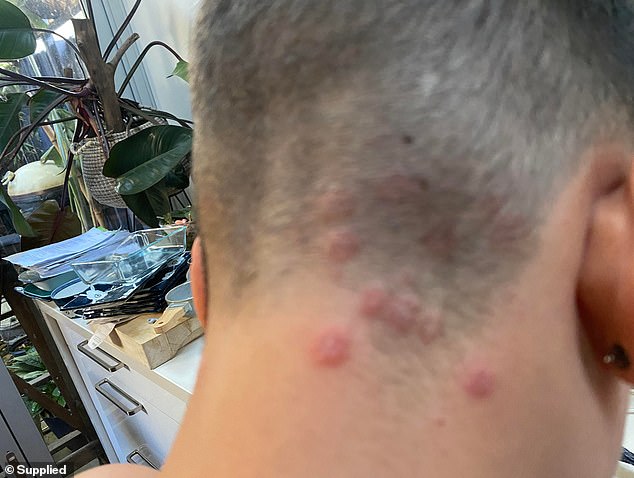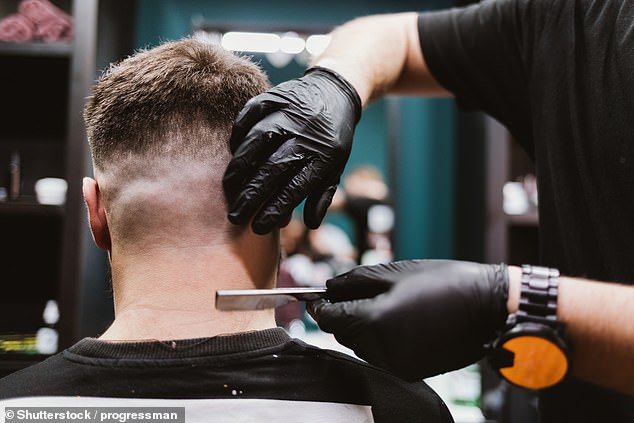Barber warns of common haircut mistake that’s leaving scores of young men infected with gruesome RINGWORM
Hairdressers today sounded the alarm over a worrying rise in the number of young men contracting ringworm from haircuts.
Cases of the contagious skin fungus that can cause disfigurement have risen significantly in just a handful of months, they claim.
Hairdressers believe this is because more and more men are opting for skin-fade haircuts – where the sides are shaved short and the length is left on top – in ‘cheap, dirty, unqualified’ shops ‘on the high street’.
But the government today said it still has ‘no plans to regulate the hairdressing sector’.
Despite ringworm’s reputation as a scalp disease among Victorian slum dwellers, it is a common fungal infection, estimated to affect between 10 and 20 percent of the population, especially children.
Transmitted by skin-to-skin contact, despite the name it is not caused by a worm.
It can also be passed through infected objects, such as sheets, combs or towels.
Mike Taylor, who runs a hairdressing training course in Poole, Dorset, said he had seen ‘loads of cases’ recently.
Cases of the contagious, disfiguring skin fungus have increased significantly in just a handful of months, they claim. Pictured: A 2022 case in Australia of a boy who contracted ringworm after a visit to the hairdresser

Hairdressers think this is because more and more men are opting for skin-fading haircuts. Pictured: A 2022 case in Australia of a boy who contracted ringworm after a visit to the hairdresser
The hairdresser who has been working in the industry for 34 years told the BBC he believes that cheaper stores fail to keep their equipment clean.
He said: ‘I would say 70 to 80 per cent of the customers who come in ask for skin fading.
‘To achieve that effect you have to use the foil cutter, but the problem is that it sucks in hair and needs to be cleaned thoroughly.’
He added: ‘The high streets are getting exhausted, dying out and then suddenly there are twelve hairdressers on the same street and they’re all trying to get a little bit cheaper than each other.
‘If prices have to be reduced, something else has to be done and perhaps it is the time spent cleaning the equipment or the time spent acquiring the right knowledge.
‘Sometimes the cheapest price is not always the best price.’
Gareth Penn, the registrar of the Hair and Barber Council, also called for a ‘compulsory register for those wishing to trade as hairdressers or barbers’.
The council, based in Hampshire, is a statutory authority for hairdressers in Great Britain. But it is currently only a voluntary register.

The photo shows an illustration of Trichophyton mentagrophytes, the cause of ringworm on the scalp

Gareth Penn, the registrar of the Hair and Barber Council, also called for a ‘compulsory register for those wishing to trade as hairdressers or barbers’
“This opens up the hairdressing industry to those who are not trained or qualified, or worse, to those who want to use our industry as a cover for illegal activities,” he said.
A government spokesperson said: ‘We have no plans to regulate the hairdressing sector, but we will always seriously consider evidence when it is provided.
‘We are working closely with the sector to meet skills and training needs, and HMRC is also working to tackle tax fraud in the sector.’
Cases of ringworm are usually treated with prescription antifungal medications such as gels and creams.
But sometimes oral antifungal medications are also necessary.
Common symptoms of the fungal infection include itching, a scaly ring-shaped area, and scattered bumps that range in color from red on white skin to reddish, brown, or gray on black skin.
Slightly raised, expanding rings or a round, flat spot of itchy skin are other key symptoms, according to the NHS.
Dr. James O’Donovan, member of an NHS medical and technical advisory group at the World Health Organisation, also advises people to avoid sharing ‘combs, hats, hairbrushes, towels and pillowcases with other people’.
In one YouTube video He has viewed the video more than 125,000 times and explained that this is “because fungi can live for a long time.”
If a child is affected, it is crucial that teachers and parents of classmates are notified, he added.
“Other family members should be examined and treated by a doctor,” he said.
‘Sometimes it is best to treat the whole family with a medicated antifungal shampoo twice a week for four weeks, regardless of whether there is a fungal infection.’
